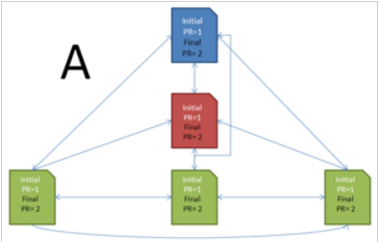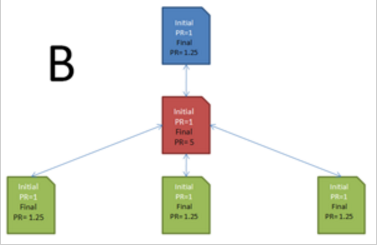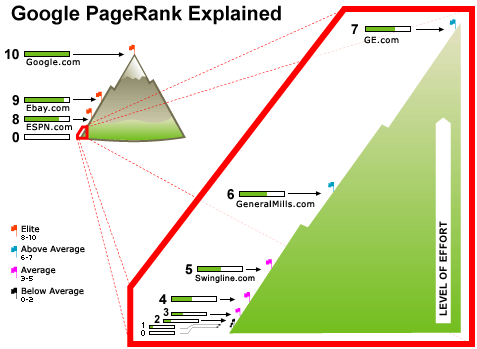Updated June 15, 2023

What is PageRank For Website and Its Calculation?
If you are involved with SEO or with Google search then you would have definitely come across this term pagerank for website at some point in time. PageRank for website is a numerical value that tells how important a page is on the internet or web. It is a quality metric which was invented by Larry Page and Sergey Brin. It is the basis of how Google works. PageRank for website is the algorithm which made Google the best search engine in the world because of its best results.
PageRank for a website is a mathematical formula that might look complex but it is actually so easy to understand. When one page links to another page Google considers that the page is casting a vote for another page. If a page gets more such votes then it means that the page is more important. The page which delivers the vote also helps to decide how important the vote is. PageRank for a website helps Google to decide the importance of a page and it is the main reason behind which the PageRank for a website is determined in the search results.
The PageRank for website algorithm assigns a numerical value to each web page. The rating of a web page is on a scale from 0 to 10.
Importance of PageRank for website
- PageRank for website will help the search engine to give the best and high quality search results which are more relevant.
- PageRank of a website will help to order the search results according to their importance and it also gives more preference to the central pages.
- The PageRank of a website calculation will help you to know some basic assumptions about the ranking algorithm and the procedure of ranking a page.
- PageRank of a website is very important because it is the deciding factor which shows up your site in the first page or last page of the search engine when a browser is searching for something related to your business or product.
Factors that impact the PageRank for website
There are several factors that have an impact on the PageRank of a website. Few are listed below
- Inbound links matter a lot
- Adding many new pages will lead to a decrease in the pagerank of a website
- If your linking partners pagerank decreases it will affect your site’s pagerank for website
- High-quality links are more important
- Links gained from popular sites are considered effective
- Illegal activities like hidden text, cloaking, link exchanges and other will penalize your pagerank
- Inbound links obtained from sites which are related to your website will help you to get a higher pagerank
- Even if your pagerank of a website is low it does not affect your ranking in the Google
- Each page on your site will have a different pagerank for website
Factors which do not have an impact on the pagerank
- Your content updates will not help to increase the pagerank of your site
- Content is not considered as a factor while calculating the pagerank of a website
- Higher pagerank does not mean that your site will get higher ranking in search engine
- Google does not consider the only pagerank. If backlink is not relevant then Google will not consider it
- Links from Wikipedia will not improve your pagerank
- Listing your site in DMOZ and Yahoo does not help you to increase your pagerank
- Even your subdirectories can have higher pagerank than your website pages
- Meta tags are not considered as a factor to improve your pagerank
- Any links from .edu and .gov sites will not help to give you higher pagerank
- Links which are marked with No Follow attribute will not contribute to your pagerank
- Even if there are multiple votes from a single site, it is considered as a single vote
- A page cannot vote for itself. Such links are not considered
- Irrelevant and bad quality links do not have an impact on pagerank
- Dangling links do not improve your pagerank. Such links simply exist without any outgoing links
Ranking factors that are related to PageRank
- Internal Onsite linking is crucial
- Anchor text matters
- Link farms are penalized by Google
- Header tags and semantic content are considered important
- The anchor text of a link is considered as an important ranking factor
How to calculate PageRank?
The equation to calculate the PageRank is mentioned below
PR (A) = (1-d) + d (PR (t1) / C (t1) + … + PR (Tn) / C (Tn))
Where PR(A) = the pagerank of your page A
d = damping factor which is usually 0.85
‘t1-in’ = pages linking to page A
C = outbound links
This equation can also be simplified as
“a page’s PageRank = 0.15 + d * (a “share” of the PageRank of every page that links to”)
Here Share = the linking page’s PageRank divided by the number of outbound links on that page
A page that links to another page cast its vote to that page. So each link on that page will create a PageRank to another page that it links to.
An important thing to consider is that the page that links to your site is as important as the number of links on that site. This is because if there are more page links on that site then the PageRank value of your site will be less. From this, we can know that the 10 outbound links from PR1 are more valuable than that from PR10 which has 100 outbound links.
People also believe that the values differ between PR1 and PR10 on a logarithmic scale. As a result, a page requires more PageRank to move from one level to the next level. Here the result reverses the previous one, a page with a lot of outbound links is more worth than the page with few outbound links.
Whatever it may be, there is one thing finally concluded, that links from another site will always help to increase your PageRank. So always avoid links from link farms.
By providing the vote to other sites the site does not lose its page value and PageRank.
How These Calculations are Done?
Now let’s look at how these calculations are done.
If for a particular page PageRank is to be calculated then that particular page’s previous PageRank is abandoned completely and a new calculation is done. The calculation is not done just once, it is calculated for the linking page as well as to the page which creates that link. The step by step calculation procedure is given below
1. Calculating the PageRank value of Page A from its inbound links
In this situation, Page A has a new pagerank value. This is based on the inbound link from page B. In case Page A has an inbound link to page B and if the Page B’s new pagerank value has not yet been calculated then the pagerank value of Page A seems to be inaccurate.
2. Calculating the PageRank value of Page B from its inbound links
Page B can have a new PageRank value because of its inbound link from Page A. But it will not be accurate because the new pagerank value of Page A was used to calculate.
This problem can be solved out by repeating the number of the calculations of times. Every time you repeat it will get slight accurate value. But you can never get accurate value because the calculations are always based on inaccurate values. After repeating the calculation over 40 to 50 times you will get a value for which no further calculations can be done to make it perfect. This is the method followed by the Google and that is why every update takes too long.
The values we get from such calculations are just proportions and after this, the values are scaled by Google to find out the exact PageRank. So we can just use the calculations to direct a pagerank within its site in order to receive a higher proportion.
Internal Linking & PageRank
If there are a lot of internal links in a site then it gets the maximum number of pagerank. The number is increased by the number of inbound links it gets from other sites and decreases by the outbound links it provides to the other sites. This is for the overall pagerank for the site and not for the individual pages of the site.
If a site has the number of pages then the amount of pagerank will also be high for the site. And the pages should be crawlable by Google. Only then it will be considered for pagerank of the site.
Bad quality internal links can reduce the pagerank of a site. At the same time, a good internal link structure will not help to exceed the maximum amount of pagerank. The only way through which you can increase your pagerank is by adding more inbound links or by increasing the number of pages of your site.
What to do with these Overall PageRank values?
If a page has to be taken into account for the calculation of pagerank then it should be indexed in Google. Google will index the site only if two or more pages on the web are linking to the page. Any page which is not indexed in the Google will not be considered for pagerank values calculation.
Let’s look at how the calculation works.
The pagerank values calculator operated in two modes – Simple and Real.
In simple mode, the calculation is done based on the assumption then the pages are in the Google index and do not consider whether there is any link to them from outside.
In real mode, the calculation does not consider the pages which do not have any links.
Here is an example is given below for your easy understanding
Example 1
In this example Page A has linked to B which has increased the pagerank for Page B. It is only one iteration and we have not taken the Catch 22 situation into account.
Before the calculation
Page A = 0.15
Page B = 1
Page C = 0.15
After repeating the calculations many times
Page A = 0.15
Page B = 0.2775
Page C = 0.15
These values are more realistic and the total pagerank value of the site is now 0.5775.
Simplified PageRank values Illustration
The simplified pagerank model is
PageRank for a particular page = Initial PageRank + (total ranking power / number of outbound links)+…
Google allocates every web page an initial pagerank value. In this example that initial value is considered as 1. If two new pages Page A and Page B are created then each page would carry an initial value 1.
If a link is directed from Page B to Page A, it will increase the pagerank of Page A to 2. Page B’s vote is considered worthy and is called ranking power. If Page B creates another link to Page C then the pagerank of Page A will come down to 1.5 whereas Page C’s pagerank will increase from 1 to 1.5.
Any more additional links from Page B to Page A will not affect its pagerank value as only one link from Page B to Page A distributes ranking power.
With this simple model, you can test the various SEO tactics for internal linking. It will help you to find out which tactic will work best for you to achieve your goal.
The below picture shows you how Google PageRank algorithm works
Google PageRank Tools
Below mentioned are a list of Google’s PageRank tools and services
- PageRank Search
- Google PageRank Inspector
- Google’s PageRank Calculator
- Visual PageRank View
- Google PageRank Notifier
- Google PageRank Checker
- Die PageRank
- Live PageRank Check
- PageRank Checker
- Smart PageRank
- PageRank Overlay
- PageRank Widget
- PageRank Decoder
- PageRank Export List History
- Google PageRank Prediction
- Google Ranking Factors
Conclusion
There is much more to write about PageRank but hope this article gives you a brief introduction about PageRank and how to calculate it. So making people link to your site is always a good thing and PageRank is a result of this. Stay focused on quality and relevant links to yours. This will increase the PageRank and in turn, will increase the visitors to your site. Do things naturally and it will take you up to great heights in your business.
Recommended Articles
This has been a guide to Pagerank for website helps Google to decide the importance of a page and it is the main reason behind which the page ranks is determined in the search results. These are the following external link related to the pagerank for website.





